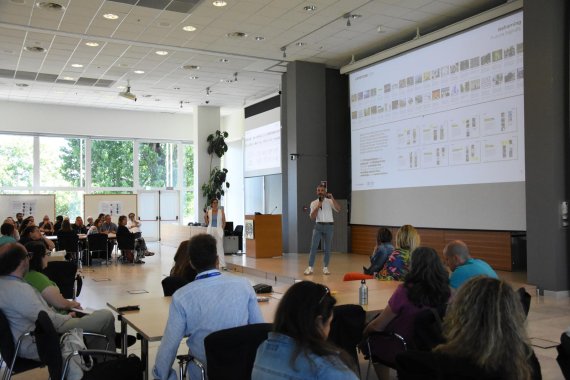BYOD
BYOD
Bring Your Own Device: Reducing carbon footprint and increasing outreach through digital platforms
19 April 2018

Bring Your Own Device, be it a laptop, tablet or smartphone, is going to be the new reality in future learning. The ITCILO has increasingly been providing tablets during its learning activities and after 3 years, it is safe to say the initiative has been quite a success. Even up to the point that it was decided to not give master students at the Turin School of Development a tablet for their learning activities, since they – just like many ITCILO participants – are already bringing their own laptops and tablets these days. This is a clear trend that indicates a shift is going to happen in the future of learning. Is our Centre ready?
The Benefits of Learning with Devices
Learning experiences have become more interactive and engaging through technology. For example, VoxVote can let 150 participants express their opinion simultaneously. The questions drafted beforehand are displayed through the app on participants’ tablets. When everyone has answered, the online software collects all data and visualizes the outcome in a graph that can be projected. It is great for speakers and trainers to get insights on what kind of audience they have in front of them. The audience, on the other hand, will have a greater sense of contribution. Another example is the Green Learning Game, which is played in pairs using a tablet or smartphone. It requires users to collaborate whilst exploring the location and networking with others.
Social learning, knowledge sharing and content creation increase through the use of mobile devices, which enable easy access to social media and other tools that allow the sharing of opinions and newly gained knowledge. Participants can tweet about an interesting statement, share a picture of new data they were exposed to, or make a Facebook Live video of their favourite speaker and share it on their networks. Digitally active participants will enter the social network of the Centre, but also bring their own professional and personal networks in touch with the Centre’s. It’s a win-win.
At the same time, the ecological footprint of the Centre is being reduced as resources and training materials become available online rather than on paper. However, do not mistake the eCampus for an online repository of PowerPoints and PDFs. If designed properly, courses on the Centre’s learning platform can be highly interactive, engaging and impactful. And there is more news on the horizon concerning the eCampus.
Let’s go mobile!
In February 2018, online learning was shifted into a higher gear with the mobile eCampus app for both Android and IOS. This means that the ITCILO’s online learning platform will not only be accessible from computers, laptops or tablets, but also smartphones. ICTS Team Leader Gaël Lams explains: “Together with an update of the eCampus, we will be launching the eCampus mobile app, allowing more mobile learning such as video-based learning and micro-learning courses. With this initiative, we will be able to improve access to courses for persons with poor or unreliable internet connections or people relying mainly on smartphones. We are aware it will take some training for staff to be able to design a mobile-friendly course and content and we are already brainstorming about ideas to launch a first staff training mobile course doing exactly that.”
This is not the Centre’s first time to take the next step when it comes to online learning and learning technologies. The eCampus that originated 5 years ago hosted more than 400 courses in 2017, and the tablets that were introduced 3 years ago are now widely used (75% of the Turin-based open courses). We should therefore not be afraid of innovation. As Mr. Lams said: “The Centre has systematically achieved the best results when working together. Collaboration between different departments and units has been a key success factor for introducing and scaling effective and innovative solutions.”
Conclusion
Learning with a device adds value to the ITCILO’s training activities. When implemented correctly, it can make participants interact and collaborate more in the classroom and share their newly gained knowledge with online networks. For the Centre, it means reducing its carbon footprint and increasing its outreach and visibility trough the content that is shared by participants. Going mobile with the eCampus will make results from those advantages mentioned above grow exponentially. Interacting with each other and sharing content will not only become easier, the ITCILO will also be able to provide training services to a new audience of participants that are most difficult to reach. Going mobile will require some effort and time, but when we work together we truly achieve great things.
Resources
To learn more on how to use tablets in training activities, check out this ITCILO publication “Mobile Learning with Tablets, a Guide for Trainers”: https://blog.itcilo.org/ mobile-learning-with-tablets-free-e-book-for-trainers/
Originally published in the Future of Learning magazine.


